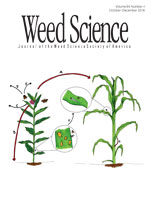Indaziflam is a cellulose biosynthesis-inhibiting herbicide for annual weed control in various agricultural systems. Sporadic cases of unacceptable injury to desirable plants have been reported after indaziflam application, which may have been due to conditions favoring increased indaziflam–soil bioavailability. Research was conducted from 2013 to 2015 on a sandy soil to elucidate the effects of soil organic matter content (SOMC) and soil volumetric water content (SVWC) on indaziflam–soil bioavailability. Indaziflam was applied (50 or 100 g ha−1) at fall only, fall plus spring, and spring only timings to plots in a factorial arrangement of SOMC, pre–indaziflam application (PrIA) SVWC, and post–indaziflam application (PoIA) SVWC. After application, field soil cores were collected for a subsequent greenhouse bioassay experiment, where foliage mass reduction of perennial ryegrass seeded from 0 to 15 cm soil depth was used as an indicator of indaziflam–soil bioavailability throughout the profile. Significant edaphic effects were observed at 0 to 2.5, 2.5 to 5, and 5 to 7.5 cm depths, with increased bioavailability at low compared with high SOMC. Pre–indaziflam application SVWC did not affect bioavailability, whereas PoIA high SVWC increased indaziflam–soil bioavailability at 2.5 to 7.5 cm depth compared with PoIA low SVWC. Low SOMC–PoIA high SVWC decreased perennial ryegrass foliage mass 40 and 37% at 5 to 7.5 cm depth from cores collected 10 and 14 wk after treatment, respectively, whereas reductions from all other SOMC–PoIA SVWC combinations were < 12% and did not vary from each other. Pearson's correlation coefficients showed a moderate, positive relationship between perennial ryegrass mass reductions at 0 to 2.5, 2.5 to 5, 0 to 5, and 0 to 10 cm depths and hybrid bermudagrass cover reduction, which suggests conditions favoring increased indaziflam–soil bioavailability can adversely affect plant growth. Data from this research will aid land managers to use indaziflam effectively without adversely affecting growth of desirable species.
Nomenclature: Indaziflam; hybrid bermudagrass, Cynodon dactylon (L.) Pers. × Cynodon transvaalensis Burtt–Davey; perennial ryegrass, Lolium perenne L.





